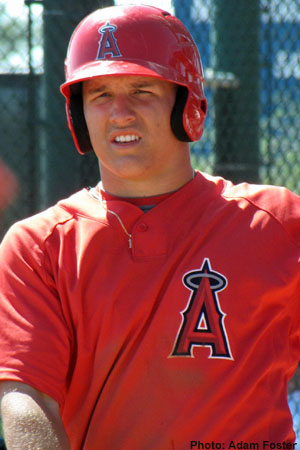
Angels prospect Mike Trout has every chance to develop into a five-tool major league outfielder. The speed, defense, arm strength, ability to hit for average and ability to get on base are already in place. His power is very projectable and should develop naturally with age.
I was able to see Trout a couple of times while he was playing in the Midwest League. Based on video I had seen of him in the past and what I saw from him with my own eyes, here is a recap of his progress, present tools and future projection.
Defense
Natural. That’s the only word I can use to describe how he moves in the field. Everything is fluid and effortless yet fast and powerful. He was reportedly clocked at 90 MPH as a pitcher in high school and his outfield arm is definitely a plus, especially for a center fielder.
Speed
There is no questioning Trout’s speed. His stolen base totals speak for themselves. However, it’s the ease of his speed that is so impressive. As you can see in the video below, Trout legs out a double and does so effortlessly. It takes him roughly 7.73 seconds from the crack of the bat until he touches second base without there even being a play at the bag. Even with the round turn as he approaches first base, Trout’s time from home to first is roughly 4.38 seconds.
Since he’s already well built with broad shoulders, the chances of him growing out of his speed are lessened, but he may still lose a bit as he grows into his mid-twenties. Still, Trout’s speed is an 80 on the 20-80 scale and should continue to be a tremendous asset throughout his career.
Adjustments
In high school, Trout held his bat on his shoulder with the bat head wrapped around the backside of his helmet. He would not move his hands much while loading his swing, but he would wrap the bat around his helmet bit more than he did in 2010. Because he has strong wrists and good bat speed he was able to get away with this in high school.
One of the first adjustments the Angels organization made with Trout was to get his hands up off of his shoulder and get his bat angle vertical rather than wrapped around his helmet. This has created a straighter path to the ball, though Trout still wraps the bat behind his helmet during the loading portion of his swing, just not as drastically. This is something I’m sure he and the coaches will continue to work on. Then again, if it's not broke why fix it?
Swing
As Trout loads his swing, he shifts his weight back slightly. His base is already wide so his stride is mostly a slight lift of the front leg. When his front leg lands his weight shifts forward, but his balance remains perfect upon the start of his swing.
Trout’s hands start by lowering just a bit while, as mentioned above, bringing the bat head down at an angle behind his helmet. There is no lateral movement in his hands and his shoulders remain level. His bat is quick through the zone and his swing path is direct to the ball. He has a quick turn of the wrists as the bat moves through the zone and his follow through is natural and smooth.
Overall Trout’s swing is quick, smooth and balanced. The only negative could be, again, the wrapping of the bat, but his hands are quick enough to make up for it. The pictures below show the swing broken down into stages. He was late on this particular pitch, so you won’t see good extension.

Projection
Many young speedsters are slender with a ton of room to build muscle. While Trout still has room to grow and strength to gain, he’s already well put together with broad shoulders and strong legs. His slugging tailed off at High-A, but he showed plenty of power for an up-the-middle defender in Low-A.
There is a wide range of what Trout’s ultimate power ceiling is. The range goes up to 25-plus home runs per season and no lower than 15. Given his strong base, broad shoulders, strong legs and wrists, Trout should have no problem driving the ball at every level.
His approach at the plate has been nothing short of fantastic given his age and levels of advancement. Even with some struggles at High-A, Trout still managed an 11.6% walk rate while continuing to limit his swings and misses and strikeouts. A .388 on-base percentage for an 18/19-year-old in High-A makes a loud statement about the type of hitter Trout is.
From the games that I saw in person, he rarely chased a bad pitch, especially early in the count as he waited for a pitch to drive. He was very good with two-strikes, shortening up his approach. Even on the one strikeout I saw he managed to make contact, fouling a high fastball straight back into the catcher’s mitt. This type of plate discipline and contact skill translates fantastically to the major league level and should give Trout a serious shot to be a perennial .300-plus hitter with a .380-.410 OBP.
The Angels found themselves a gem in Mike Trout. It wouldn’t surprise me to see him represent that organization in all-star games annually. He could see the big leagues as soon as the end of 2011 and has a serious chance to turn into a regular in 2012.
Discuss this article in our forums >>>
Charlie Saponara is a former college baseball player who has since spent time as a high school and college coach. He also worked for the Rancho Cucamonga Quakes. He can be reached by email at cs.fb365@gmail.com and @fb365 on Twitter.
